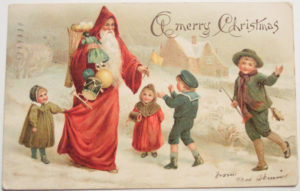 The holiday season is truly a time of magic and whimsy as anyone who has seen the Nutcracker or read Charles Dickens’ A Christmas Carol will confirm. The weeks after Thanksgiving leading to New Years are filled with a tangible energy of peace and harmony that often brings out the kind and charitable side of people even amidst a frenzy of materialistic gift buying. It was not until recently that I’ve realized that on a deeper level, the final weeks of the year are on a deeper level, a time of magic and intensely heightened spiritual activity. This first came to my attention on a snowy late November afternoon in Cluj-Napoca, Romania while I sat sipping eggnog with my friend Elena. Our conversation, as it often does, turned to themes of the occult and supernatural and Elena told me that in traditional Romanian peasant folklore the final days of November into December are considered a time of magic where many important and powerful saints’ have their feast days in close proximity to each other and in years past there was even a belief that farm animals can talk during this special time of the year. In today’s post, we will take a look at a few of the holy and traditions that make this time of year so special and magical.
The holiday season is truly a time of magic and whimsy as anyone who has seen the Nutcracker or read Charles Dickens’ A Christmas Carol will confirm. The weeks after Thanksgiving leading to New Years are filled with a tangible energy of peace and harmony that often brings out the kind and charitable side of people even amidst a frenzy of materialistic gift buying. It was not until recently that I’ve realized that on a deeper level, the final weeks of the year are on a deeper level, a time of magic and intensely heightened spiritual activity. This first came to my attention on a snowy late November afternoon in Cluj-Napoca, Romania while I sat sipping eggnog with my friend Elena. Our conversation, as it often does, turned to themes of the occult and supernatural and Elena told me that in traditional Romanian peasant folklore the final days of November into December are considered a time of magic where many important and powerful saints’ have their feast days in close proximity to each other and in years past there was even a belief that farm animals can talk during this special time of the year. In today’s post, we will take a look at a few of the holy and traditions that make this time of year so special and magical.
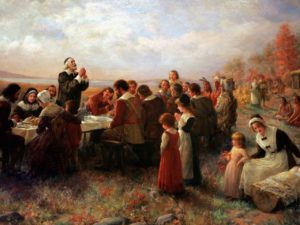 In America, we are used to Thanksgiving kicking off the holiday season. I have always enjoyed Thanksgiving and I definitely feel that having a national day of giving thanks puts us in the mood to be more kind and charitable during the Christmas season in which greed and materialism tend to rear their ugly heads despite the season’s message of love and goodwill towards others. Thanksgiving however is a comparatively new observance compared to the others we will discuss, but I felt it was important to include it since it is highly spiritual in its origins and I do feel that it’s important to have a day where we formally stop our busy activities and give thanks for the blessings we have. I understand and sympathize with many Native-Americas who have a strong dislike for this holiday because of its glorification of colonization which was the beginning of the loss of their land and the decline of their people, but I choose to focus of the aspect of Thanksgiving that teaches us to give thanks to God and each other for the blessing we have in life. I have traveled and lived in many parts of the world and many people have told me that of all the American holidays that have been exported the one that has not been promulgated and that they wish would take root is Thanksgiving since it is a day not of commercialism but of kindness and gratitude.
In America, we are used to Thanksgiving kicking off the holiday season. I have always enjoyed Thanksgiving and I definitely feel that having a national day of giving thanks puts us in the mood to be more kind and charitable during the Christmas season in which greed and materialism tend to rear their ugly heads despite the season’s message of love and goodwill towards others. Thanksgiving however is a comparatively new observance compared to the others we will discuss, but I felt it was important to include it since it is highly spiritual in its origins and I do feel that it’s important to have a day where we formally stop our busy activities and give thanks for the blessings we have. I understand and sympathize with many Native-Americas who have a strong dislike for this holiday because of its glorification of colonization which was the beginning of the loss of their land and the decline of their people, but I choose to focus of the aspect of Thanksgiving that teaches us to give thanks to God and each other for the blessing we have in life. I have traveled and lived in many parts of the world and many people have told me that of all the American holidays that have been exported the one that has not been promulgated and that they wish would take root is Thanksgiving since it is a day not of commercialism but of kindness and gratitude.
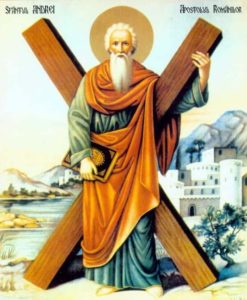 As we inch closer to Christmas, we come to Saint Andrew’s Day which falls on the 30th of November. In many Eastern European countries and in Scotland it is an official holiday. We have touched upon this day in previous posts as Saint Andrew’s Day, and especially the night preceding it, are known to be times of heightened supernatural activity. Saint Andrew was the first called of the apostles and is credited for spreading the gospel to Eastern Europe where his following remains particularly strong to this day. In Romanian folklore, Saint Andrew is the patron saint of vampires and werewolves and offers protection against such creatures that are said to be at their most powerful on the night of the 29th of November, so much so that Romanian peasant hang garlands of garlic around their windows and even rub down the window sills and farm animals with a peeled clove of garlic on this night. Wild roses also offer protection against supernatural creatures of the night. In Poland, Saint Andrew’s Eve is a night of divination especially in matters of love. Molten lead or candle wax are dripped into a basin filled with cold water and information about one’s future spouse is divined according to the shape the lead or wax takes when cooled by the water. In Austrian folklore, it is said that if you go to the apple orchard on St. Andrews Eve and cut a small branch from an apple tree and place it in warm water until it blossoms, you can carry it to the local church and you will be granted the power to see who the village witches are. It seems to me that if a person perform this ritual, he or she might be well on his/her way to becoming the village witch! Of course I love witches of all spiritual paths who use their powers for good and live lives of kindness towards others. I do enjoy St. Andrew’s Eve and Day very much and to me it serves almost like an official end to fall and the beginning of winter and all the beauty that the coldest season brings.
As we inch closer to Christmas, we come to Saint Andrew’s Day which falls on the 30th of November. In many Eastern European countries and in Scotland it is an official holiday. We have touched upon this day in previous posts as Saint Andrew’s Day, and especially the night preceding it, are known to be times of heightened supernatural activity. Saint Andrew was the first called of the apostles and is credited for spreading the gospel to Eastern Europe where his following remains particularly strong to this day. In Romanian folklore, Saint Andrew is the patron saint of vampires and werewolves and offers protection against such creatures that are said to be at their most powerful on the night of the 29th of November, so much so that Romanian peasant hang garlands of garlic around their windows and even rub down the window sills and farm animals with a peeled clove of garlic on this night. Wild roses also offer protection against supernatural creatures of the night. In Poland, Saint Andrew’s Eve is a night of divination especially in matters of love. Molten lead or candle wax are dripped into a basin filled with cold water and information about one’s future spouse is divined according to the shape the lead or wax takes when cooled by the water. In Austrian folklore, it is said that if you go to the apple orchard on St. Andrews Eve and cut a small branch from an apple tree and place it in warm water until it blossoms, you can carry it to the local church and you will be granted the power to see who the village witches are. It seems to me that if a person perform this ritual, he or she might be well on his/her way to becoming the village witch! Of course I love witches of all spiritual paths who use their powers for good and live lives of kindness towards others. I do enjoy St. Andrew’s Eve and Day very much and to me it serves almost like an official end to fall and the beginning of winter and all the beauty that the coldest season brings.
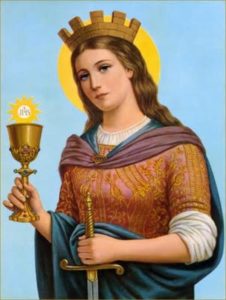 December 4th is the feast of Saint Barbara. A powerful and legendary saint whom we have discussed previously. Barbara was martyred in the 3rd century by her own father who had previously kept her prisoner in a tower. She is venerated in the Roman Catholic and Orthodox churches throughout Europe and the Middle East. In fact, in Lebanon her feast day takes on a carnival like spirit with costumes, plays and special sweet treats similar to the Jewish celebration of Purim. In Romania, on the eve of St. Barbara’s feast day it is a custom for unmarried women to go to the cherry orchard and cut a twig from a tree and place it in warm water. If the twig blossoms before the New Year, marriage is in store for the year to come. I have noticed that in many of the winter observances of European countries and especially in Scandinavia, it is common to force flower bulbs and other types of plants to bloom out of season perhaps as a reminder amidst the darkest and coldest days of the year that the warm summer months will return.
December 4th is the feast of Saint Barbara. A powerful and legendary saint whom we have discussed previously. Barbara was martyred in the 3rd century by her own father who had previously kept her prisoner in a tower. She is venerated in the Roman Catholic and Orthodox churches throughout Europe and the Middle East. In fact, in Lebanon her feast day takes on a carnival like spirit with costumes, plays and special sweet treats similar to the Jewish celebration of Purim. In Romania, on the eve of St. Barbara’s feast day it is a custom for unmarried women to go to the cherry orchard and cut a twig from a tree and place it in warm water. If the twig blossoms before the New Year, marriage is in store for the year to come. I have noticed that in many of the winter observances of European countries and especially in Scandinavia, it is common to force flower bulbs and other types of plants to bloom out of season perhaps as a reminder amidst the darkest and coldest days of the year that the warm summer months will return.
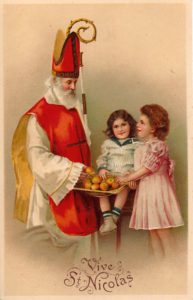 The 6th of December is the feast of Saint Nicholas who of course is the inspiration for the modern Santa Claus due to his reputation for kindness and acts of charity. According to legend, during his time as bishop of Myra, he was known to place small gifts and money inside stockings that people had hung to dry by the fire hence the modern practice of stuffing Christmas stockings. All across Europe, on the night of December 5th, children place their own shoes or decorative wooden shoes under their beds or by the front door and at some point during the course of the evening the shoes are mysteriously filled with candy or small gifts after a visit from St. Nicholas. Children who have been naughty will often receive a switch cut from a tree and decorated with colorful ribbons. Such small gifts and colorful switches are sold at makeshift markets that pop up in cities all over Europe during the early days of December. I buy a switch with bells and ribbons every year to use as a cat toy. Amidst all the gift giving and fun traditions associated with St. Nicholas’ Day and with Christmas, it’s important to remember the charitable example of kindness and goodwill lived by Saint Nicholas which is the true essence of the Christmas season.
The 6th of December is the feast of Saint Nicholas who of course is the inspiration for the modern Santa Claus due to his reputation for kindness and acts of charity. According to legend, during his time as bishop of Myra, he was known to place small gifts and money inside stockings that people had hung to dry by the fire hence the modern practice of stuffing Christmas stockings. All across Europe, on the night of December 5th, children place their own shoes or decorative wooden shoes under their beds or by the front door and at some point during the course of the evening the shoes are mysteriously filled with candy or small gifts after a visit from St. Nicholas. Children who have been naughty will often receive a switch cut from a tree and decorated with colorful ribbons. Such small gifts and colorful switches are sold at makeshift markets that pop up in cities all over Europe during the early days of December. I buy a switch with bells and ribbons every year to use as a cat toy. Amidst all the gift giving and fun traditions associated with St. Nicholas’ Day and with Christmas, it’s important to remember the charitable example of kindness and goodwill lived by Saint Nicholas which is the true essence of the Christmas season.
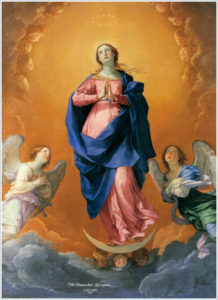 The 8th of December is the Feast of the Immaculate Conception which compared to the other holy days of this list is a relatively recent feast day first instituted in 1708 as a Holy Day of Obligation in the Roman Catholic Church that falls during the liturgical season of Advent which is a time of penitence and spiritual preparation for Christmas. The feast itself commemorates the dogma of the Immaculate Conception of the Blessed Virgin Mary which states that from the moment of her conception the Virgin Mary was preserved from original sin. Despite its comparatively recent institution as a universal feast, this day has become a special part of the holiday season and in many countries throughout the world it is a public holiday with parades, fireworks, family gatherings and of course religious observances. The Feast of the Immaculate Conception is the patronal feast of the United States and traditionally in Catholic circles it is on this day that people send out Christmas cards.
The 8th of December is the Feast of the Immaculate Conception which compared to the other holy days of this list is a relatively recent feast day first instituted in 1708 as a Holy Day of Obligation in the Roman Catholic Church that falls during the liturgical season of Advent which is a time of penitence and spiritual preparation for Christmas. The feast itself commemorates the dogma of the Immaculate Conception of the Blessed Virgin Mary which states that from the moment of her conception the Virgin Mary was preserved from original sin. Despite its comparatively recent institution as a universal feast, this day has become a special part of the holiday season and in many countries throughout the world it is a public holiday with parades, fireworks, family gatherings and of course religious observances. The Feast of the Immaculate Conception is the patronal feast of the United States and traditionally in Catholic circles it is on this day that people send out Christmas cards.
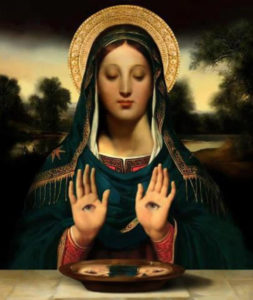 As we draw closer to the winter solstice and of course Christmas, we come to the feast of Saint Lucy on the 13th of December. Saint Lucy was a young martyr from Syracuse, Sicily who met a gruesome death at the hands of her Pagan captors when she refused to make a sacrifice on behalf of the provincial governor as to do so would go against her Christian faith. She was known for great acts of charity towards the poor even going as far as to distribute her considerable personal fortune and jewels to those less fortunate. Her captors first attempted to burn her at the stake but the wood would not ignite around her so she met her martyrdom by sword after which her eyes were gouged from her head, but when she was laid to rest in her family mausoleum it was discovered they her eyes had mysteriously reappeared. Due to this legend, she became known as the patron saint of the blind and those who suffer from eye diseases. Due to the fact that her feast day falls during the darkest days of the year, Saint Lucy’s day has become known as a festival of light especially in Scandinavia where the winters and long and dark. In the northern European countries it is common for the youngest daughter of a family to bring her parents breakfast in bed on Saint Lucy’s Day while wearing a crown of lit candles. Lighting candles is a traditional part of Scandinavian St. Lucy’s Day celebrations as well as the general Christmas season to bring light into the darkest days of the year and as a reminder that the days will soon grow longer. I have never personally celebrated Saint Lucy’s Day, although I do admire her as a great saint and example of charity and piety. I did once visit a shrine dedicated to her in northern Portugal and have beautiful memories of lighting a candle and seeking her blessing and protection.
As we draw closer to the winter solstice and of course Christmas, we come to the feast of Saint Lucy on the 13th of December. Saint Lucy was a young martyr from Syracuse, Sicily who met a gruesome death at the hands of her Pagan captors when she refused to make a sacrifice on behalf of the provincial governor as to do so would go against her Christian faith. She was known for great acts of charity towards the poor even going as far as to distribute her considerable personal fortune and jewels to those less fortunate. Her captors first attempted to burn her at the stake but the wood would not ignite around her so she met her martyrdom by sword after which her eyes were gouged from her head, but when she was laid to rest in her family mausoleum it was discovered they her eyes had mysteriously reappeared. Due to this legend, she became known as the patron saint of the blind and those who suffer from eye diseases. Due to the fact that her feast day falls during the darkest days of the year, Saint Lucy’s day has become known as a festival of light especially in Scandinavia where the winters and long and dark. In the northern European countries it is common for the youngest daughter of a family to bring her parents breakfast in bed on Saint Lucy’s Day while wearing a crown of lit candles. Lighting candles is a traditional part of Scandinavian St. Lucy’s Day celebrations as well as the general Christmas season to bring light into the darkest days of the year and as a reminder that the days will soon grow longer. I have never personally celebrated Saint Lucy’s Day, although I do admire her as a great saint and example of charity and piety. I did once visit a shrine dedicated to her in northern Portugal and have beautiful memories of lighting a candle and seeking her blessing and protection.
I hope you have enjoyed this brief look at a few of the special holidays and observances associated with the Christmas season and I wish you have a truly magical holiday season and abundant blessings in the New Year!